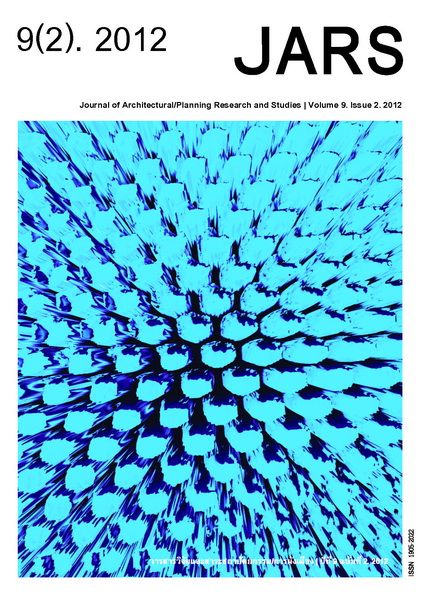The Detached House and Design Modification Guidelines for Adaptable Housing for Elderly People
Main Article Content
Abstract
This study is the first part of a research project sponsored by Thammasat University. The study is interested in the interior architectural design of detached houses and how to modify them to be supportive and safe for elderly people, in line with the adaptable housing concept. The contribution of this study is for people building or purchasing their houses in preparation for aging. The case studies are housing estates located in Bangkok and metropolitan areas in the high-end (5-10 MB) and mid-range (3-5 MB) price ranges. The interior environment is studied to examine how it meets accessible housing design criteria and how to design these houses according to the concept of adaptable housing design. The findings from 16 case studies suggest that all require some level of alterations. Two major factors affecting the ease of alteration are the interior architectural designs and the usable first floor area of each house. The areas where major alterations are required are the ramp for an extra entrance, interior circulation, an accessible bathroom and suitable electrical outlet heights respectively, all of which require structural demolitions prior to reconstruction. However, the living and dining areas involve less problems. Following areas are downstairs’ bedroom, outdoor balcony, kitchen and laundry respectively. The houses with the least potential for modification are those with several different floor levels on one plane. In conclusion, pre-design and pre-consideration of the house to accommodate adaptation for elderly people, especially items requiring structural alterations, is necessary.
Downloads
Article Details

This work is licensed under a Creative Commons Attribution-NonCommercial-NoDerivatives 4.0 International License.
All material is licensed under the terms of the Creative Commons Attribution 4.0 International (CC-BY-NC-ND 4.0) License, unless otherwise stated. As such, authors are free to share, copy, and redistribute the material in any medium or format. The authors must give appropriate credit, provide a link to the license, and indicate if changes were made. The authors may do so in any reasonable manner, but not in any way that suggests the licensor endorses you or your use. The authors may not use the material for commercial purposes. If the authors remix, transform, or build upon the material, they may not distribute the modified material, unless permission is obtained from JARS. Final, accepted versions of the paper may be posted on third party repositories, provided appropriate acknowledgement to the original source is clearly noted.
References
Australian Institute of Health and Welfare [AIHW]. (2002). Ageing in place: before and after the 1997 aged care reforms. AIHW Bulletin, 26(1), 1-12.
Bundhamcharoen, K., & Sasat, S. (2008). ระบบการดูแลระยะยาว: การวิเคราะห์เปรียบเทียบเพื่อเสนอแนะเชิงนโยบาย [Long-term care: Comparative analysis for policy recommendation]. Rama Nurs J, 14(3), 396.
Demirkan, H. (2007). Housing for the aging population. European Review of Aging and Physical Activity, 1(4), 33-38.
Gilleard, C., Hyde, M., & Higgs, P. (2007). The impact of age, place, aging in place, and attachment to place on the well-being of the over 50s in England. Research on Aging, 29(6), 590-605.
Lawton, M. P. (1989). Three functions of the residential environment. Journal of Housing for the Elderly, 5(1), 35-50.
Master Builder’s Association [ACT]. (2001). Housing for life. Retrieved July 8, 2012, from http://www.mba.org.au/files/view/?id=310.
Pattanawasin, S. (2010). บ้านเดี่ยวขนาดย่อมแบบเปิดคอร์ทโล่ง: รูปแบบที่พักอาศัยทางเลือกสำหรับบริบทเมืองใหญ่ในภูมิภาคเขตร้อนชื้น [Courtyard compact house: Alternative living pattern for uUrban context in tropical regions]. Journal of Architectural/Planning Research and Studies, 7(2), 119-139.
Piratchapan, P. (2000). การวิจัยเพื่อพัฒนาคุณภาพชีวิตของผู้สูงอายุในสังคมไทยด้านอาชีพ เศรษฐกิจ และกฎหมาย [Research for development the quality of life of the elderly in Thai society in terms of occupation, economics, and laws]. Retrieved July 8, 2012, from http://www.stou.ac.th/Thai/Research/Group1/index.asp.
Pynoos, J., Mayeda, A., & Lee, C. (2003). Home modification resource guide. Los Angeles, CA: University of Southern California, The National Resource Center on Supportive Housing and Home Modification.
Pynoos, J., Nishita, C., Cicero, C., & Caraviello, R. (2008). Aging in place, housing, and the law. Elder Law Journal, 16(1), 78-81.
Pynoos, J., Nishita, C., & Perelman, L. (2003). Advancements in the home modification field: A tribute to M.
Powell Lawton. Journal of Housing for the Elderly,17(1-2), 105-116.
Pynoos, J., Sanford, J. A., Rosenfelt, T., & Browne, A. (2002). A Team approach for home modifications. OT Practice, 7(7), 15-19.
Wagnild, G. (2008). Growing old at home. Journal of Housing for the Elderly, 14(1-2), 71-84.


